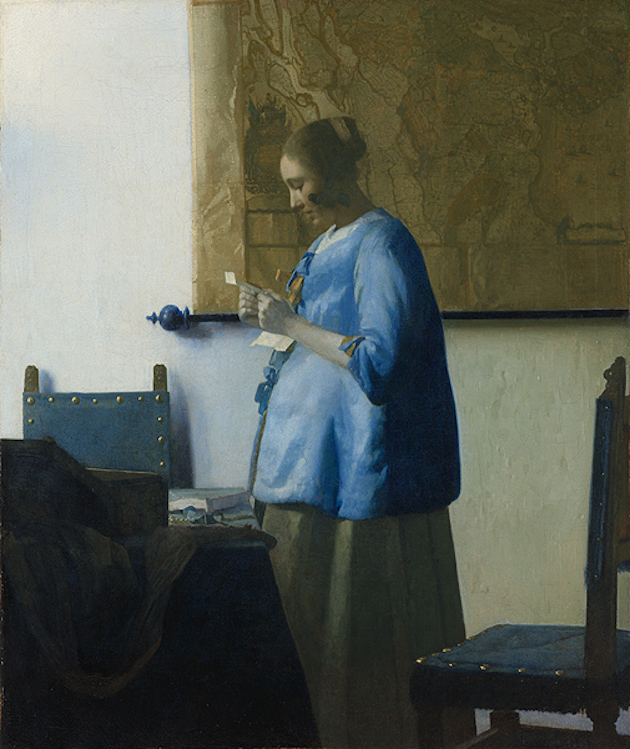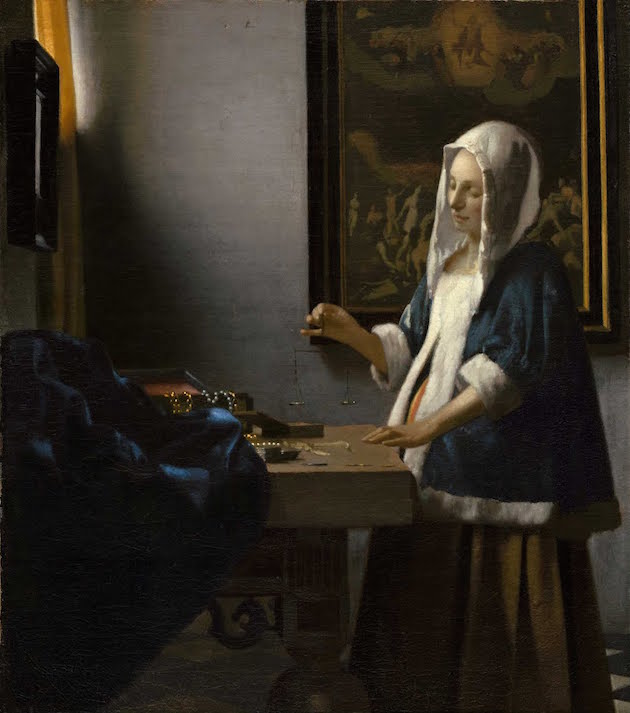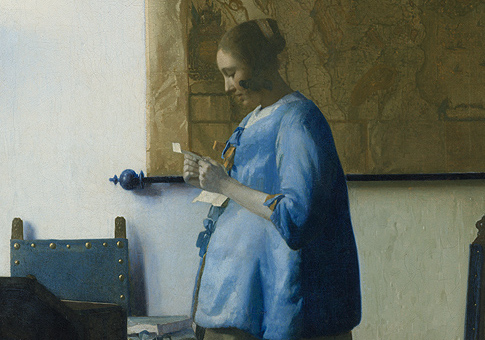In May of 1921, with a little over a year to live, Proust left his apartment to visit an exhibit of Dutch painting at the Jeu de Paume. There he saw, among other canvases, Vermeer’s ‘View of Delft’ and ‘Girl with a Pearl Earing.’ This pleased him greatly, but his fragile health was shaken, and he never went outside again.
The purpose of the excursion was nonetheless fitting, for Vermeer had played an important role in Proust’s intellectual life. Having been forgotten for centuries, the Dutch realist was one of those early modern painters (El Greco was another) whose work caught the eye of the Third Republic’s avant garde. In Vermeer’s case, something about the startling photographic quality of his work, its focus on domestic scenes, his way of conveying space and texture through color, was appealing.
Proust transformed his last outing into the death of Bergotte in the fifth volume of À la recherche du temps perdu:
At last he came to the Vermeer which he remembered as more striking, more different from anything else that he knew, but in which, thanks to the critic's article, he noticed for the first time some small figures in blue, that the sand was pink, and, finally, the precious substance of the tiny patch of yellow wall. His dizziness increased; he fixed his gaze, like a child upon a yellow butterfly that it wants to catch, on the precious little patch of wall. "That's how I ought to have written," he said. "My last books are too dry, I ought to have gone over them with a few layers of color, made my language precious in itself, like this little patch of yellow wall."
Then Bergotte dies, right there in the gallery. The scene I observed in the Cabinet Galleries of the NGA’s Dutch and Flemish rooms this week was somewhat less dramatic.
The main event is Vermeer’s ‘Woman in Blue Reading a Letter,’ on view through December 1. The wall depicted in this painting is not only yellow. What on cursory examination seems to be a simple surface is in fact a multicolored assembly of yellows, whites, and even blue—where the cold northern light shining through the window appears to be reflecting off the woman’s morning dress. This is indeed a surface "precious in itself."

‘Woman in Blue’ is on loan from the Rijksmuseum in honor of the twentieth anniversary of the 1995 Vermeer exhibit at the National Gallery, in which a stunning 21 works from the master were on display, including the ‘View of Delft.’ The current loan still makes it possible for visitors in Washington this fall to see four Vermeers in one room—a not insignificant event, when one considers that the catalogue of the non-prolific artist only numbers thirty-odd paintings. (It should have been possible for visitors to see five Vermeers at once, but for some reason the NGA isn’t also showing ‘A Lady Writing.’) On display from the NGA’s own collection is the marvelous ‘Woman Holding a Balance,’ along with the noticeably less marvelous ‘Girl with a Flute’ and the ‘Girl with the Red Hat’—the most impressive fact about which seems to be the remarkable amount of money Andrew Mellon spent for it, having caught his own case of Vermeer fever.

‘Woman in Blue’ and ‘Woman Holding a Balance’ are structurally very similar—but so are most Vermeers, almost all painted in the same Delft studio, using a small and rotating set of models, props, and furniture. Woman in Blue’s rather expensive looking chairs, decorated with carved lion heads, also make an appearance in the Frick’s ‘Girl Interrupted at Her Music,’ Berlin’s ‘The Glass of Wine,’ the British Royal Family’s ‘The Music Lesson,’ the Met’s ‘Woman with a Lute’ and ‘Young Woman with a Water Pitcher,’ in the other paintings owned by the NGA, with the exception only of ‘Woman Holding a Balance,’ and in more besides. The map on the wall behind the ‘Woman in Blue’ that depicts Holland (it is oriented such that west is up—that is the estuary of the Rhine draining away from the model’s head) also appears in the Frick’s ‘Officer and Laughing Girl.’
Modern viewers are often tempted to think that the woman in blue is pregnant, caught up in some moment of suspense related to her condition—but scholars inform us that such a scene is unlikely for Dutch painting of the period, and what appears to be her swollen belly is only a padded skirt. Still, this ambiguous depiction of a young, contemplative woman receiving news of some sort calls to mind the Annunciation. It is not only the knowledge that Vermeer converted to Catholicism with his marriage that prompts the thought, but also that color blue: It is ultramarine, derived from crushed lapis lazuli imported at great cost into the Dutch Republic from Badakhshan, northeast of Kabul. In earlier eras devoted to devotional painting, it was most frequently employed to depict the clothing of the Virgin, for which the expense was thought justified.
The staging, the simplicity, the restrained and deceptively simple palette, the apparent domesticity: This is a sort of realism, but not in the sense of transcription or journalism. This scene, like all of Vermeer’s mature scenes, is highly artificial and controlled. Vermeer has nevertheless come to stand for the perfection of "Dutch realism," or at least of a certain modern stereotype of that period.
This seems to be the kind of art that self-ruling, prosperous burghers should have wanted to buy: superficially modest, but hardly making a virtue of poverty; democratic yet spiritual; dignified; an enduring rejection of the Baroque and of absolutism and excess in all their forms. But the enduring popularity of the artist no doubt has to do less with his communication of the tastes of a particular historical moment, and more with what Bergotte observed in his final moments: that there is something precious in itself about Vermeer’s way of seeing color.
